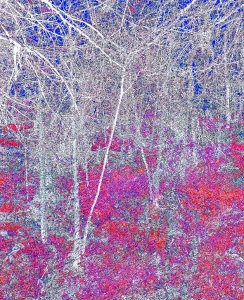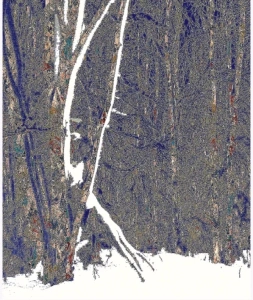PAINTING

Québec, Canada. 2023
FOREST OF BUCKLAND
Resonance: Echoes of a Canada in Full Ferment
In the heart of the vast Canadian landscapes unfolds a poignant narrative through the lens of a camera and the magic of digital montage. Each pixel added in my artistic project, titled 'Resonance,' symbolizes the time our trees take to bud in spring. This artistic endeavor aims to capture both the tragedy and beauty that unfold when nature roars, when the flames of forest fires dance, and when climate upheaval leaves its mark in this pivotal year, 2023.
Hundreds of thousands of hectares of land have been engulfed by flames, exposing the vulnerability of our ecosystems to the whims of climate change. Rising temperatures, relentless droughts, and the proliferation of forest fires have pushed our nation to the brink. 'Resonance' captures this alarming reality by illustrating the splendor of the forests of Quebec, my homeland.
At the core of this series lies a call to action, a plea to contemplate the urgency of a global fight against climate change. Canadian wildfires are not an isolated phenomenon but a warning bell amidst the global challenges humanity faces. The salvation of our Canadian forests in the face of this climate upheaval directly depends on the measures we take to mitigate its effects. Each of my works tells the story of a vulnerable ecosystem, a tangible reality that could vanish—a call for collective action.
A key element of my work is shedding light on the transition to digital, which can contribute to the preservation of our forests. Each of my works materializes in digital form. Forests taking shape pixel by pixel, in a meticulous digital process, transform into thermo-relief prints on recycled supports. This technique was chosen because of my conviction that the gradual abandonment of paper in favor of digital technology represents a step towards reducing deforestation. My photographic works illustrate the beauty of this transition, emphasizing the advantages it offers in terms of tree preservation and forest protection.
'Resonance' is not just a visual testament; it's a wake-up call and an ode to nature's resilience in the face of adversity. I hope this project inspires awareness and action, urging each one of us to unite in protecting our planet and securing our future.
Karine Detcheverry"



FOREST OF BUCKLAND, Québec, Canada 2023
Thermographie, impression thermo-relief sur support recyclé

Sète, Montpellier
ÉTANG DE THAU
A PLACE, ARTWORKS.
Karine Detcheverry circled the Thau Lagoon, later interpreting it in her studio with a highly personal perspective. In 'Impact on Landscape,' this former Quebec architect provides a highly graphic and almost monochromatic view of the lagoon. Unexpected and refreshing to the eye.
Having arrived in the region eight years ago, Karine Detcheverry holds an affection for the coast, the Mediterranean, and the lagoons. Yet, this Quebec native casts a fresh gaze, allowing us to rediscover places observed countless times before.
"I walked around a lot, took photos—landscapes, the beaches of Sète in the summer—shots anyone could take, serving merely as a starting point to develop studio work. What intrigued me throughout this series was the impact of humans on the landscape."
With this guiding theme, the artist created works that are more or less figurative but share common characteristics: large formats, a predominantly black and white palette subtly accented with colors, an intentional graphic quality. When color emerges boldly, it doesn't enhance the sky or the water; instead, it abstractly signifies human influence on these territories.
Karine Detcheverry studied architecture, then worked in advertising and theater in Quebec before pursuing film studies in Denmark. Today, all these influences converge in her painting. "With this work, I've reconnected with an approach akin to that of architects: we appropriate a place, offer our version. Here, I've transformed things into a rather poetic universe."
Working directly on photographic enlargements or, conversely, starting with a blank canvas, Karine Detcheverry gradually presents her vision of the lagoon: layer by layer, blending acrylic paints and sepia ink, sometimes staying true to the landscape or adding more or less abstract elements. This portrayal stands far from the vividly colored depictions often associated with Southern France landscapes.
On the horizon, the hills of Sète or Agde or a less defined hinterland; in the foreground, the horizontals of water and the verticals of oyster park stakes, the white of the water, the black of the stakes, all filled with vibrations akin to any aquatic landscape. And when Karine Detcheverry evokes the beaches of Sète in the summer, she uses the same pictorial language, but this time, the black of the figures and the white of the beach blend, horizontals and verticals intersect. Human presence encroaches upon the whole.
In total, the artist created around twenty canvases in this series, which were exhibited in April at the Agnès B. gallery in Montpellier before traveling to Quebec and Portugal.
Text by Jean Ibanez"

Yukon, Canada. 2014
LES NAGEUSES DE WOLF-LAKE
THE BREATH OF THE WORLD
One day, in November, for a few hours, in a wild landscape of Canada, hundreds of women gather to swim in the icy waters of a lake. Karine Detcheverry's photo-paintings tell us the story of this strange and mysterious ritual. She shows us a choreography of bodies that appear and disappear within the amorphous, liquid, and mineral mass of Wolf Lake. This lake, an immobile expanse, suddenly becomes agitated, unstable. Stirred from within, it comes back to life as these bodies regenerate upon contact with its icy water.
Like a herd during its migration, gathering at a water point to drink, all these women rediscover their animality, their collective nature by merging with the elements. The foam produced by the friction of water and bodies awakens, for us Europeans, the unsettling strangeness of the goddess Aphrodite ('aphros' in Greek: foam), born from the violence of the god Kronos who emasculated his father, Ouranos (the Sky), to emerge from the womb of his mother, Gaia (the Earth). In his Theogony, Hesiod tells us that from this savage act was born Aphrodite, this foam, this 'aphros' that formed when the blood and semen of Ouranos fell into the sea. Could we, in this feminine and collective experience of Wolf Lake, be in an Aphrodisiac ritual ?
In this encounter between the cold of the icy lake waters and the warmth of the bodies, we are caught in a contradiction, that of sensory experience and aesthetic judgment. Indeed, the cold, the ice, is what freezes our emotions, what keeps our empathy at a distance. Our gaze is as if deconditioned, destabilized in its codes and social representations by the work of bodies and Karine's pictorial work, retouching her photos with material, with paint. This is where her entire artistic work is played out: understanding, at the same time, the necessity of the photographic image while combating its power of crystallization, of death. The touches of paint, touches of colors, enhance, intensify the luminous glow of the water's foam.
Karine's photo-paintings do not show us dives, bodies breaking the water's surface from the outside. What we see are bodies, bits of bodies: heads, legs, knees that emerge at the water's surface. We are there, at the edge, on the surface, in a very organic, very archaic struggle to breathe. The mixed technique of Karine's works expresses the necessity of the porosity of living beings. Here, the pores of the photographic image are the symbolic and metaphorical space of the swimmers' skin pores and the surface of the lake. Being closest and farthest from the bodies, alternating between highly precise, highly realistic images where we can see legs, knees, heads, and abstract images where the swimmers' heads are nothing but black dots on the luminous surface of the water, Karine stages the very movement of the world's breath.
Text by Jean Ibanez"

